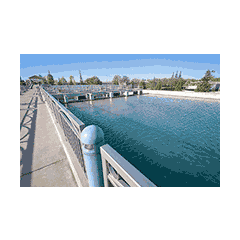This weekend, ABC10 in California ran a story about an alarming discovery, which may have resulted in residents exposure to a carcinogenic compound in the drinking water. The City of Sacramento decided to test a new chemical coagulant, called aluminum chlorohydrate, commonly known as ACH.

ACH helps clean the water by bonding with impurities, forming heavier than water compounds that then fall to the bottom of treatment pools. This sediment is them removed. Sacramento had used a previous chemical, known as ALUM, but they were hoping the new chemical would be more cost effective.
It turns out that the ACH required the treatment facility to inject more chlorine, which had unintended side effects. We asked a water treatment engineer to explain:
"It sounds like they injected more chlorine to get the required kill 4-log (99.99% of cryptosporidium, giardia, and virus) because the ACH wasn't removing enough organics. They should have ran more jar tests... Usually you'd want to use less chlorine for less formation of DBPs.
From my cursory reading of the article, it seemed like ACH didn't remove enough organics so they added more chlorine to get 4-log kill. When chlorine and the organics mix and mingle, like in the distribution system, DBPs are formed."
The DBP's that formed are carcinogenic, and records show that these may have been above safe levels of exposure. There seems to be some disagreement as to whether the testing was proper and the public received proper notification.
We passed this article around the office, and someone asked the question, what is aluminum chlorohydrate? We thought it was a good opportunity to review a safety data sheet.
The Characteristics of Aluminum Chloroydrate
We pulled up a safety data sheet for aluminum chlorohydrate to learn more. We highlighted the interesting and relevant things we learned.
Section 1 - Chemical Product & Company Identification
This section tells is it is an inorganic metal salt, and it's general use is for water treatment.
Section 2 - Composition / Information on Ingredients
Here we learn that the OSHA exposure limit is 2 mg/m3. The ACGIH makes the same recommendation.
Section 5 - Physical and Chemical Properties
It is completely water solubility, so it would mix well with drinking water. It has a specific gravity of 1.32 - 1.35, so it is heavier than water and would fall to the bottom.
